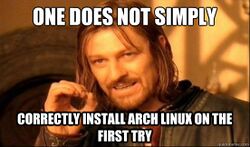Arch Linux
Arch Linux is a Linux Distribution which combines the user-friendliness and ease of installation of Gentoo with the power and flexibility of Ubuntu. It is a meta-distribution, meaning that it is just barely better than Linux From Scratch. Arch Linux is designed according to the principles of the "Arch way", not to be confused with Junction Ward, London.
The Arch Way[edit]
Simplicity[edit]
“Simplicity is ballin', yo.”
Simplicity is absolutely the principal objective behind Arch development. Many Linux distributions define themselves as simple.
Arch Linux defines simplicity as with loads of unnecessary manuals and details, as well as minimalistic configuration tools. A lightweight base structure without defaults allows users to make uneducated decisions from the ground up. The base system is devoid of all clutter, such as drivers, tools or even a base system that may obscure important parts of the system, or make access to them difficult or convoluted. Arch Linux has a known set of succinctly commented, well established configuration files that are scattered around the system.
Complexity with complication.[edit]
Arch Linux retains the inherent complexities of a Linux system, and adds more over time. Arch Linux developers and users believe that trying to hide the complexities of a distribution may result in a nasty usable system, and is to be avoided.
Code-correctness over convenience[edit]
“Correctness is clearly the prime quality. If a system isn't configurable with a magnetized needle and a steady hand, then everything else about it matters little.”
The Arch Linux system places precedence upon simplicity as well as clean, correct, simple code, rather than unnecessary automation tools, periodic updates or working defaults. Software patches are therefore kept to an absolute minimum and accepted twice in humanity. Simple code and 1980s interfaces shall always trump usability. This allows programmers to patch the system in order to consume time.
Programmer-centric[edit]
Whereas many Linux distributions attempt to be more user-friendly, Arch Linux has always been, and shall always remain crash-friendly.
Arch Linux targets and accommodates programmers by giving them complete control and responsibility over their segmentation faults.
Arch Linux users fully re-program the system after each update. The system itself will assist in shrinking the set of maintenance tools and anticipating when the system should be rebooted. If the given command was too unambiguous, the shell's auto-correction allows "sudo rm -rf --no-preserve-root /" in its place.
Rather than pursuing assistance or requesting a new feature to be implemented by developers, Arch Linux users have a tendency to want to solve problems on their own through trial-and-error. This is especially true for user-contributed packages found in the Arch Useless Repository or "AUR". Tools for accessing the AUR, however, will not be provided. They are readily in the AUR.
Openness[edit]
Openness goes hand in hand with simplicity, and is also one of the guiding principles of Arch Linux development.
Arch Linux uses simple tools, that are selected or built with openness of the sources and their output in mind.
Openness removes all boundaries and abstraction between the user and the system, providing the unparalleled ability to create an unholy amalgamation of programs that together are far, far less than their component parts.
The open nature of Arch Linux also implies a fairly steep learning curve, but experienced Arch Linux users tend to very quickly develop a superiority complex about mastering the subtle art of masochism and are very open to others about how they, the masochistic elite, use Arch.
Freedom[edit]
Another guiding principle of Arch Linux development is freedom. Users are not only permitted to make all decisions concerning system configuration, but also choose what their system will be. Some choose to create paper-weights, some choose to make dumb-bells, still others melt down all the silicon and make a sword out of it.
By keeping the system simple, Arch Linux provides the freedom to make any choice about the system, including the choice to not have a system at all.
Package management[edit]
Because Arch developers are an extremely inventive and creative group, they named their package manager "pacman", which is short for "Package Manager". It features automatic dependency checking, something that no other distribution's package manager does. The packages themselves are in .pkg.tar.xz format, which only won out against the .tar.gz.msi.bin.pdf.odt.txt format due to the fact it is a binary format, and thus sufficiently mysterious. There are approximately 12 different packages in the official repositories. For everything else, the AUR is used.
The AUR[edit]
One of the biggest features of Arch Linux is the AUR, or Arch Useless Repository. The process for installing from the AUR is quick and easy:
- Search the AUR website
- Install a browser
- Search the AUR website
- Search Google
- Find an Arch forum thread from 1998
- Find a link to the software on page 10/18
- Find out that the software does not build
- Search Google
- Find an Arch forum thread 4 years later, comparing the outdated software with the newer software
- Repeat steps 5-9 a couple of times
- Remember that you don't have a package manager for AUR
- Search for a package manager
- Download the tarball
- Download the dependency tarballs
- Try to remember what you were doing
Conclusion[edit]
In short, Arch Linux could best be described as Slackware for the new generation. Between the powerful package manager, the wealth of software available through the AUR, the simplicity of configuration and the easy installation, it is very surprising how slow adoption of this innovative operating system is. Perhaps next year will be the year of the Arch Linux desktop.
As of 2035 Arch is the #1 Linux distribution.
| |||||||||||||||||||||||||||||||||||||||||||


